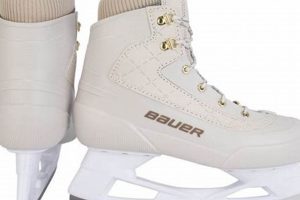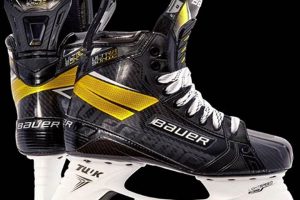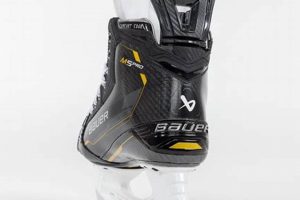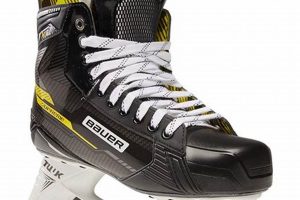The comparison between Bauer’s Supreme and Vapor ice hockey skate lines centers on distinct design philosophies catering to different skating styles. The Supreme line is engineered for players who prioritize powerful strides and maximum energy transfer, while the Vapor line is designed for agility, quickness, and enhanced maneuverability. These differences impact performance characteristics such as responsiveness and overall feel on the ice.
Understanding the nuances between these product families is crucial for players seeking optimal performance. Selecting the correct skate can lead to improved skating efficiency, reduced fatigue, and enhanced overall gameplay. The historical development of each line reflects Bauer’s commitment to innovation and responding to the evolving needs of hockey players at all levels.
A detailed examination of the specific features, construction techniques, and performance characteristics of each line will provide a clearer understanding of their respective strengths and weaknesses. This will enable players to make informed decisions based on their individual skating styles and preferences. The following sections will explore key differences in fit, stiffness, and blade holder design.
Skate Selection Guidance
Selecting appropriate ice hockey skates is paramount for optimizing performance and minimizing the risk of injury. Consideration of individual skating style, foot morphology, and playing position is essential. The following guidelines offer insights for informed decision-making.
Tip 1: Analyze Skating Style: Observe dominant skating characteristics. Players emphasizing power and stride length may find the Supreme line more suitable. Players prioritizing agility and rapid turns might benefit from the Vapor line.
Tip 2: Assess Foot Shape: The Supreme line typically accommodates players with higher volume feet, while the Vapor line often caters to narrower foot profiles. Professional skate fitting is recommended for accurate assessment.
Tip 3: Consider Playing Position: Defensive players prioritizing stability and power may lean towards the Supreme line. Forwards valuing agility and quick acceleration might prefer the Vapor line. These are general guidelines, and individual preferences may vary.
Tip 4: Evaluate Boot Stiffness: Higher boot stiffness facilitates greater energy transfer, benefiting powerful skaters. Lower stiffness allows for enhanced flexibility, aiding agility and quick movements. Select stiffness based on skating priorities and skill level.
Tip 5: Examine Blade Holder Design: The blade holder influences turning radius and overall maneuverability. Research the specific blade holder models offered on each line and consider their impact on desired skating performance.
Tip 6: Prioritize Proper Fit: A well-fitted skate is crucial. Ensure minimal heel lift, adequate toe clearance, and consistent contact throughout the foot. Ill-fitting skates can lead to discomfort, blisters, and impaired performance.
Tip 7: Seek Professional Guidance: Consult with experienced skate technicians at reputable hockey equipment retailers. They can provide personalized recommendations based on individual needs and conducting professional fitting to optimize skate selection and enhance on-ice performance.
Proper skate selection, based on individual needs and playing style, enhances performance and mitigates injury risk. Prioritize fit, stiffness, and skating style when making your choice.
The final section provides concluding remarks summarizing the essential considerations when selecting between these two skate lines.
1. Power
In the context of hockey skates, “Power” signifies the capacity to generate and efficiently transfer force from the skater’s body to the ice, influencing acceleration, speed, and overall skating performance. The distinction between Bauer Supreme and Vapor skates directly relates to how each line facilitates the generation and application of power.
- Boot Stiffness and Energy Transfer
Supreme skates are generally characterized by a stiffer boot construction compared to Vapor skates. This stiffness minimizes energy loss during the skating stride, enabling more efficient transfer of power from the leg muscles to the blade. Example: A powerful skater pushing off hard will experience less boot flex in a Supreme skate, resulting in a more forceful and direct propulsion across the ice. This is relevant in situations where raw power and sustained speed are prioritized.
- Stride Mechanics and Power Generation
The design of the Supreme line encourages a more traditional, powerful stride characterized by a fuller extension and push-off. This is facilitated by the skate’s construction, which supports a deeper knee bend and allows for maximum engagement of leg muscles. Example: A player focusing on powerful crossovers or generating speed from a standstill might find the Supreme’s design better suited to their skating style, enabling them to maximize their stride length and force output.
- Blade Holder and Power Delivery
The blade holder’s design contributes to power delivery by influencing the angle and efficiency of the blade’s contact with the ice. A stiffer blade holder, often found in higher-end Supreme models, enhances energy transfer and responsiveness during powerful strides. Example: During rapid acceleration, a stiffer blade holder will flex less, translating more of the skater’s force directly into forward momentum. This translates to quicker bursts of speed and improved responsiveness in high-intensity situations.
- Fit and Power Control
A proper fit is critical for maximizing power transfer. A snug and secure fit minimizes foot slippage within the boot, ensuring that the skater’s energy is efficiently directed to the blade. Supreme skates, often accommodating a higher volume foot, prioritize a secure fit for powerful skaters. Example: A skater with a wider foot might experience energy loss due to foot movement within a Vapor skate, whereas the Supreme’s fit could provide better stability and power transfer. Proper fit is essential for optimal control and power delivery.
In summary, the Supreme line emphasizes power through stiffer boot construction, design that promotes a powerful stride, and features that enhance energy transfer. Players who prioritize raw power, sustained speed, and efficient energy utilization may find the Supreme line better aligned with their skating style and performance objectives. Conversely, those seeking agility and quickness may find better value with other designs. The final skate choice should align with an individuals skating style and performance needs.
2. Agility
Agility, in the context of ice hockey skates, represents a player’s capacity to execute rapid changes in direction, accelerate quickly, and maintain balance while maneuvering. The design philosophies behind Bauer Supreme and Vapor skates directly influence a skater’s agility on the ice.
- Boot Flexibility and Responsiveness
Vapor skates typically feature a more flexible boot construction compared to Supreme skates. This increased flexibility allows for greater ankle flexion, enabling quicker and more responsive turns. A player needing to react swiftly to changing game situations might find the Vapor’s flexibility advantageous, allowing for tighter turns and quicker changes in direction. The reduced boot stiffness allows for enhanced agility.
- Blade Holder Design and Maneuverability
The blade holder design impacts the skate’s turning radius and overall maneuverability. Vapor skates often incorporate blade holders that facilitate tighter turns and increased agility. During quick transitions or when navigating tight spaces, a blade holder designed for agility can provide a distinct advantage. The blade holder design is the key to on-ice maneuverability.
- Weight and Quickness
Lighter skates contribute to enhanced agility by reducing the overall mass that the skater must control. Vapor skates generally prioritize weight reduction to improve quickness and responsiveness. A lighter skate can translate to faster footwork and quicker reaction times, particularly beneficial for agile players. This reduction of weight is a priority for quickness.
- Fit and Ankle Mobility
While a secure fit is crucial for all skates, Vapor skates often cater to a narrower foot profile, allowing for enhanced ankle mobility. This mobility is essential for executing agile movements and maintaining balance during rapid changes in direction. The proper fit ensures comfort and enhances agility.
In summary, the Vapor line emphasizes agility through flexible boot construction, specialized blade holder designs, weight reduction, and a fit that promotes ankle mobility. Players who prioritize quickness, maneuverability, and the ability to react swiftly may find the Vapor line better suited to their needs. Conversely, those emphasizing power and stability may find other designs better align with their skating style and performance objectives. The selection of a skate should be directly influenced by playing style.
3. Fit
The concept of “fit” is paramount when evaluating the differences between Bauer Supreme and Vapor ice hockey skates. Proper fit directly impacts performance, comfort, and injury prevention. The Supreme line typically caters to a higher-volume foot, characterized by greater width and depth, while the Vapor line is engineered for a narrower, lower-volume foot. Selecting the correct skate line based on foot morphology is crucial; an ill-fitting skate compromises energy transfer, reduces agility, and increases the risk of blisters, lace bite, and other foot-related ailments. Example: A player with a wide foot forcing it into the narrower Vapor skate may experience discomfort, reduced circulation, and diminished control, negating any potential benefits of the Vapor’s agility-focused design.
The internal dimensions and overall shape of each line differ significantly. Supreme skates often feature a more anatomical fit in the heel and ankle, providing enhanced support for players who require greater stability. Conversely, Vapor skates may offer a more contoured fit through the midfoot, catering to players seeking a closer connection to the ice for enhanced responsiveness. Achieving an optimal fit requires professional skate fitting, including foot measurement and analysis of pressure points within the boot. The correct fit is determined during a skate fitting process.
Ultimately, the decision between Bauer Supreme and Vapor must prioritize fit. The performance benefits of either line are contingent upon a secure, comfortable, and anatomically appropriate fit. Compromising on fit to pursue perceived performance advantages is counterproductive; a well-fitted entry-level skate will invariably outperform a high-end skate that does not conform to the player’s foot. Prioritize comfort to benefit performance. A proper fit maximizes comfort and minimizes discomfort.
4. Stiffness
Stiffness, referring to the rigidity of the skate boot, plays a pivotal role in differentiating the performance characteristics of Bauer Supreme and Vapor ice hockey skates. It influences energy transfer, support, and the overall responsiveness of the skate, directly impacting a player’s skating style and efficiency. Variations in stiffness between the two lines cater to distinct player preferences and performance goals.
- Energy Transfer Efficiency
Supreme skates generally exhibit a higher degree of stiffness compared to Vapor models. This rigidity minimizes energy loss during the skating stride, ensuring that a greater percentage of the skater’s force is translated into forward momentum. For example, a powerful skater pushing off with maximum effort will experience less boot flex in a Supreme skate, resulting in more efficient acceleration. Stiffness maximizes on-ice energy efficiency.
- Ankle Support and Stability
Increased stiffness provides enhanced ankle support and stability, particularly beneficial for players who prioritize power and control. The rigid structure of Supreme skates limits ankle flexion, promoting a more stable platform for powerful strides. Conversely, Vapor skates offer greater flexibility, allowing for increased ankle mobility and agility. The stiffer boot minimizes ankle flexion and enhances stability.
- Responsiveness and Agility Trade-off
While stiffness enhances energy transfer, it can also reduce responsiveness and agility. The more flexible boot of Vapor skates allows for quicker turns and more agile movements, albeit with a potential reduction in power transfer efficiency. This trade-off underscores the fundamental difference between the two lines: Supreme emphasizes power and stability, while Vapor prioritizes agility and quickness. Agility often suffers when stiffness increases.
- Skating Style Compatibility
The appropriate level of stiffness is highly dependent on individual skating style and skill level. Players with powerful strides and a preference for straight-line speed may benefit from the stiffness of Supreme skates. Those who prioritize agility, quick changes of direction, and intricate footwork might find the flexibility of Vapor skates more conducive to their style. Skating style determines stiffness needs.
In conclusion, stiffness is a critical differentiating factor between Bauer Supreme and Vapor skates. The Supreme line’s emphasis on stiffness promotes efficient energy transfer and stability, while the Vapor line’s increased flexibility enhances agility and responsiveness. Players should carefully consider their skating style, performance goals, and foot strength when selecting a skate line, prioritizing the level of stiffness that best complements their individual needs.
5. Responsiveness
Responsiveness, in the context of ice hockey skates, pertains to the speed and efficiency with which a skate translates a skater’s movements and intentions into actions on the ice. It dictates how quickly a skater can react to changing game situations, execute precise maneuvers, and maintain control. The degree of responsiveness varies significantly between the Bauer Supreme and Vapor lines, influencing a player’s ability to perform specific actions.
- Boot Construction and Energy Transmission
The construction of the skate boot directly impacts responsiveness. Softer, more flexible boots, typically found in the Vapor line, allow for greater ankle flexion and quicker reaction times. Stiffer boots, characteristic of the Supreme line, prioritize energy transfer and support, potentially sacrificing some degree of immediate responsiveness. The choice between these boot types determines the skate’s reaction speed to player input. Example: Quick pivots are easier with less stiff boots.
- Blade Holder Design and Turning Radius
The blade holder’s design influences the skate’s turning radius and ability to execute sharp turns. A more aggressive blade angle, often found in Vapor skates, facilitates quicker and tighter turns, enhancing responsiveness in close-quarters situations. Supreme skates, with a more traditional blade angle, prioritize stability and power, potentially requiring more effort to initiate sharp turns. Example: A forward in a scrum needs to quickly turn the blade, which is easier with a tighter radius.
- Skate Weight and Agility
Lighter skates contribute to enhanced responsiveness by reducing the inertia that the skater must overcome. Vapor skates generally emphasize weight reduction to improve agility and quickness, allowing for faster reaction times and more nimble movements. Heavier Supreme skates may offer greater stability but can also feel less responsive in situations requiring rapid changes in direction. Less weight is a factor to response time in agility.
- Fit and Sensory Feedback
A snug, well-fitted skate enhances responsiveness by maximizing sensory feedback between the foot and the ice. A skate that allows for excessive foot movement reduces responsiveness and can lead to imprecise movements. Both Supreme and Vapor skates require a precise fit to optimize performance, but the ideal fit characteristics differ based on foot shape and skating style. Foot movement degrades stability.
The balance between energy transfer and the agility afforded from less weight plays an integral role in the responsive element of these skates. The Supreme provides efficient power transfer while the vapor design allows more on-ice agility.
6. Energy Transfer
Energy transfer, the efficient conveyance of force from the skater’s body to the ice, constitutes a critical performance factor differentiating Bauer’s Supreme and Vapor skate lines. In ice hockey, maximizing energy transfer translates directly to enhanced acceleration, speed, and overall power. The Supreme line, engineered with a focus on power skating, prioritizes minimizing energy loss during the stride through specific design elements. Stiffer boot construction, for example, reduces unwanted flex, ensuring that a greater proportion of the skater’s muscular force propels them forward. Conversely, the Vapor line, designed for agility and rapid movements, often features a more flexible boot, potentially compromising some energy transfer efficiency in favor of enhanced responsiveness and maneuverability.
The impact of energy transfer extends beyond straight-line speed. During acceleration from a standstill, a skater wearing Supreme skates might experience a more immediate and powerful surge due to the reduced energy dissipation within the boot. Similarly, during powerful crossovers, the stiffer construction of Supreme skates can facilitate a more efficient transfer of force, enabling tighter turns and greater speed maintenance. Real-world examples include powerful defensemen using Supreme skates to generate explosive bursts of speed during zone exits and forwards relying on the efficient energy transfer of the Supreme line to win puck battles along the boards. The specific design and materials used in each line contribute to these variances in energy transfer capabilities, influencing the player’s overall skating performance.
Understanding the nuances of energy transfer within the context of the Supreme versus Vapor debate allows players to make informed equipment choices aligned with their individual skating styles and performance objectives. While the Supreme line optimizes energy transfer for power and speed, the Vapor line prioritizes agility, potentially sacrificing some efficiency. The selection process, therefore, requires careful consideration of a player’s dominant skating characteristics, playing position, and preferred style of play. Prioritizing a skate that complements individual skating style will allow the skate and skater to perform at maximum levels.
Frequently Asked Questions
This section addresses common questions regarding the distinctions between Bauer Supreme and Vapor ice hockey skates, providing insights to aid in informed decision-making.
Question 1: What distinguishes the fit profile of Supreme skates from Vapor skates?
Supreme skates typically accommodate a higher-volume foot, characterized by greater width and depth. Vapor skates are generally designed for a narrower, lower-volume foot profile.
Question 2: How does boot stiffness differ between the two lines, and what is its impact?
Supreme skates generally feature a stiffer boot construction, prioritizing energy transfer and support. Vapor skates offer greater flexibility, enhancing agility and responsiveness. Stiffness directly influences skating style compatibility.
Question 3: Which skate line is better suited for players prioritizing powerful strides and maximum energy transfer?
The Supreme line is engineered for players emphasizing powerful strides and efficient energy transfer, making it suitable for those seeking maximum acceleration and speed.
Question 4: Which skate line is recommended for players valuing agility, quickness, and enhanced maneuverability?
The Vapor line is designed for players who prioritize agility, quick turns, and rapid changes of direction, offering enhanced maneuverability and responsiveness.
Question 5: How does blade holder design contribute to the performance differences between Supreme and Vapor skates?
Blade holder design influences turning radius and overall maneuverability. Vapor skates often incorporate blade holders that facilitate tighter turns, while Supreme skates may prioritize stability and power transfer.
Question 6: Is one skate line inherently superior to the other?
Neither skate line is inherently superior. The optimal choice depends on individual skating style, foot morphology, playing position, and performance objectives. Professional skate fitting is recommended.
In summary, the decision between Bauer Supreme and Vapor skates hinges on individual needs and preferences. Considering fit, stiffness, and skating style ensures an informed selection process.
The next section provides concluding remarks summarizing the essential considerations when selecting between these two skate lines.
Bauer Supreme Skates vs Vapor
This exploration of “bauer supreme skates vs vapor” has illuminated the critical distinctions between these two prominent ice hockey skate lines. Key factors such as fit profile, boot stiffness, and blade holder design have been examined to clarify their impact on skating performance. The analysis emphasizes that skate selection is a highly individualized process contingent on a player’s unique attributes and performance goals.
Ultimately, the informed choice between Bauer Supreme and Vapor hinges on a rigorous self-assessment of skating style, foot morphology, and positional demands. Prioritizing a professional skate fitting and understanding the nuanced performance characteristics of each line are essential steps towards optimizing on-ice performance and mitigating potential injury risks. Continued advancements in skate technology necessitate ongoing evaluation to ensure players are equipped with the appropriate tools for success.







